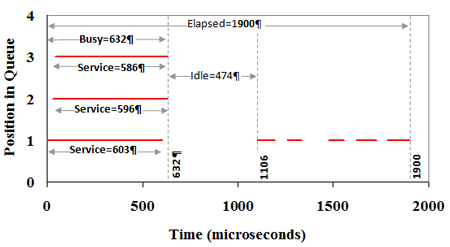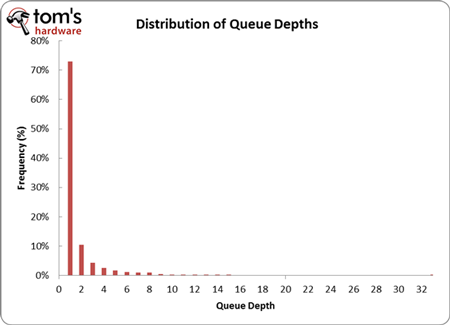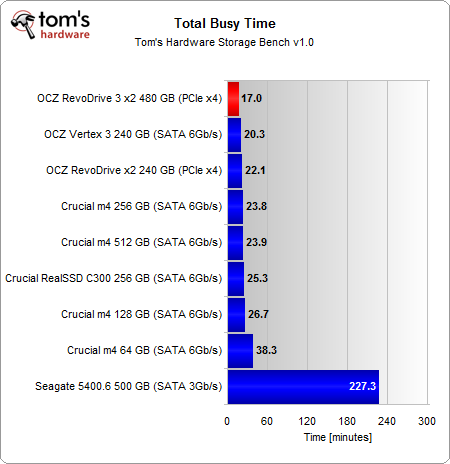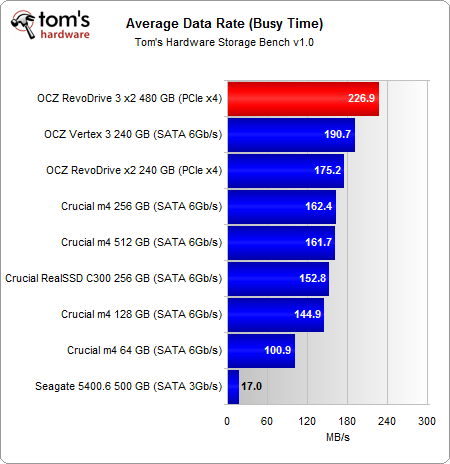The OCZ RevoDrive 3 X2 Preview: Second-Gen SandForce Goes PCIe
Storage Bench v1.0: Real-World Analysis
Real-World Analysis
We're going to kick off our analysis of the RevoDrive 3 X2 using Storage Bench v1.0 because it allows us to examine the real performance of an SSD within the first two weeks of use.
Storage Bench v1.0 involves two time-oriented metrics in addition to speed: busy and service time.
- Busy time is the total time a drive has an operation in progress.
- Service time is a little different. The total service time for the three operations in the diagram is 1785 s, which is longer than the busy time, because the operations are queued three-deep.
Service time gives more weight to periods of high queue depth (QD), while busy time gives more weight to periods of low queue depth. If you're a desktop user, busy time is a more relevant measure because you're less likely to be running workloads that impose a high queue depth.
How do we know that you should be looking at numbers that represent a low queue depth, rather than high-depth numbers most SSD vendors use to reflect peak performance? Look at the distributions of QDs in Storage Bench v1.0 in the chart below.
If you're using a hard drive or an entry-level SSD, you're more likely to encounter queue depths between two and five. But if you're using a mainstream or performance-oriented SSD, you'll mostly see a queue depth of one. This is because operations complete so much faster on a higher-end SSD that they don't have an opportunity to stack up.
Now, in the case of OCZ's RevoDrive 3 X2, the company expects you to use a vastly different usage model. This isn't a device you buy to browse the Web or compose email. It boasts high potential sequential throughput and random I/O performance, so it's best-suited to tasks that push either or both specifications.
Get Tom's Hardware's best news and in-depth reviews, straight to your inbox.
As a result, what we'll see from this more day-to-day trace is how the RevoDrive 3 performs in relation to competing SSDs in a workload that reflects an average user.
Busy time and average data rate are directly tied to one another, but looking at both allows us to examine performance in a slightly different way. Even though we're examining performance at a lower queue depth than where the RevoDrive 3 optimally runs, it still sits at the head of the pack. It's 16% faster than a single 240 GB Vertex 3 and 25% times faster than the original RevoDrive X2.
If this is how you use your computer, the takeaway is that a single 240 GB Vertex 3 is ample to satisfy.
With an average data rate of 226.9 MB/s, the RevoDrive 3 X2 takes performance to the max. The Vertex 3 falls in a close second at 190.7 MB/s, 35 MB/s behind.
Current page: Storage Bench v1.0: Real-World Analysis
Prev Page What's Important: Steady State Performance Next Page 4 KB Random Performance: Throughput-
warmon6 ReplyIt's not a business-class product. It's for the power user who is able to tax it using the right workload. If you're not one of those folks, the RevoDrive 3 X2 is seriously overkill.
OVERKILL?!?!
Nothing is overkill in the computer arena in terms of performance. :p
Just the price can be over kill. o.0 -
acku Santa is going to need a bigger expense account... :)Reply
Personally, I'm hoping that OCZ adds TRIM prior to September.
Cheers,
Andrew Ku
TomsHardware.com -
greenrider02 I saw defense of the Vertex 3's occasional low numbers, but no mention of the solid (and sometimes better) performance that the cheaper and more miserly Crucial m4 showed throughout your tests.Reply
Perhaps you have some bias towards the Vertex 3 that needs reconsideration?
Other than that, $700 seems like a fair price when considering the performace difference, especially if utilized properly, for instance as a high traffic web/corporate server -
acku greenrider02I saw defense of the Vertex 3's occasional low numbers, but no mention of the solid (and sometimes better) performance that the cheaper and more miserly Crucial m4 showed throughout your tests.Perhaps you have some bias towards the Vertex 3 that needs reconsideration?Other than that, $700 seems like a fair price when considering the performace difference, especially if utilized properly, for instance as a high traffic web/corporate serverReply
If you read the first page then you know that I give a nod to Vertex 3s as the fastest MLC based 2.5" SSD. I consider that plenty of love. :).
We'll discuss the lower capacity m4s in another article. FYI, I suggest that you read page 5 and page 6. We are not testing FOB. We are testing steady state. That's part of the reason the SF-based drives are behaving differently with incompressible data.
On your second point, this is in no way targeted toward an enterprise environment (that's what Z-drives are for). There is no redundancy in the array if a single SF controller fails. The whole card is a dud afterward. You can add higher level redundancy, but enterprise customers have so far been nervous on SandForce products. Plus, there's a general preference for hardware vs. software redundancy. (That's them talking not me). Overall, this makes it unacceptable for any enterprise class workload.



